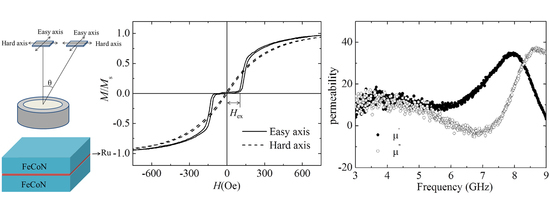Marked Enhancement of Roll-Off Frequency in FeCoN Synthetic Antiferromagnetic Films Deposited by Oblique Incidence
Abstract
:1. Introduction
2. Methods
3. Results and Discussion
4. Conclusion
Author Contributions
Funding
Conflicts of Interest
References
- Luo, M.; Zhou, P.; Liu, Y.; Wang, X.; Xie, J. Electric-Field-Induced Amplitude Tuning of Ferromagnetic Resonance Peak in Nano-granular Film FeCoB-SiO2/PMN-PT Composites. Nanoscale Res. Lett. 2016, 11, 493. [Google Scholar] [CrossRef] [PubMed]
- Li, Z.; Liu, Y.; Zheng, H.; Zhu, W.; Min, Z.; Zhang, L.; Zhou, P.; Chen, H.; Xin, W.; Lu, H. Thickness-dependent Magnetic and Microwave Resonance Characterization of Combined Stripe Patterned FeCoBSi Films. Nanoscale Res. Lett. 2018, 13, 97. [Google Scholar] [Green Version]
- Zhang, X.; Wang, S.; Zhou, J.; Li, J.; Jiao, D.; Kou, X. Soft magnetic properties, high frequency characteristics, and thermal stability of co-sputtered FeCoTiN films. J. Alloy. Compd. 2009, 474, 273–278. [Google Scholar] [CrossRef]
- Liu, M.; Li, S.; Duh, J.G. High-frequency ferromagnetic properties of FeNdBO thin films. J. Alloy. Compd. 2008, 455, 516–518. [Google Scholar] [CrossRef]
- Kittel, C. On the theory of ferromagnetic resonance absorption. Phys. Rev. 1948, 73, 155. [Google Scholar] [CrossRef]
- Wang, Y.; Zhang, H.; Wen, D.; Zhong, Z.; Bai, F. Magnetic and high frequency properties of nanogranular CoFe-TiO2 films. J. Appl. Phys. 2013, 113, 291. [Google Scholar] [CrossRef]
- Fu, Y.; Yang, Z.; Miyao, T.; Matsumoto, M.; Liu, X.X. Morisako, Induced anisotropy in soft magnetic Fe 65 Co 35 /Co thin films. Mater. Sci. Eng. B 2006, 133, 61–65. [Google Scholar] [CrossRef]
- Li, Z.; Sen, Q.; Xing, W.; Jianliang, X.; Longjiang, D. Effect of multilayer structure on high-frequency properties of FeCo/(FeCo)0.63(SiO2)0.37 nanogranular films on flexible substrates. Nanoscale Res. Lett. 2013, 8, 1–4. [Google Scholar]
- Tomita, H.; Sato, T.; Mizoguchi, T. Oblique-field annealing effect for in-plane magnetic anisotropy of soft magnetic Co-Nb-Zr thin films. IEEE Trans. Magn. 1994, 30, 1336–1339. [Google Scholar] [CrossRef]
- Li, S.; Huang, Z.; Duh, J.G.; Yamaguchi, M. Ultrahigh-frequency ferromagnetic properties of FeCoHf films deposited by gradient sputtering. Appl. Phys. Lett. 2008, 92, 3747. [Google Scholar] [CrossRef]
- Pardavi-Horvath, M.; Ng, B.G.; Castano, F.J.; Korner, H.S.; Garcia, C.; Ross, C.A. Angular dependence of ferromagnetic resonance and magnetization configuration of thin film Permalloy nanoellipse arrays. J. Appl. Phys. 2011, 110, 053921. [Google Scholar] [CrossRef]
- Zhang, L.; Zheng, H.; Zhu, W.; Li, M.; Zhang, M.; Liu, Y.; Wang, X.; Wang, N.; Harris, V.G.; Xie, J. High frequency magnetic properties of multistriped patterned FeCoBSi thin films. J. Alloy. Compd. 2017, 706, 318–321. [Google Scholar] [CrossRef]
- Phuoc, N.N.; Le, T.H.; Ong, C.K. FeCoHfN thin films fabricated by co-sputtering with high resonance frequency. J. Alloy. Compd. 2011, 509, 4010–4013. [Google Scholar] [CrossRef]
- Kuo, C.L.; Li, S.; Duh, J.G. Development and optimisation of FeCoHfN soft magnetic thin films with high-frequency characteristics. Appl. Surf. Sci. 2008, 254, 7417–7420. [Google Scholar] [CrossRef]
- Wang, Z.; Xu, C.; Wang, J.; Chang, Q.; Zuo, Y.; Li, X. Interface properties of bilayer structure Alq 3 /Fe 65 Co 35. Appl. Surf. Sci. 2015, 333, 119–125. [Google Scholar] [CrossRef]
- Yan, L.; Liu, Z.W.; Tan, C.Y.; Ong, C.K. High frequency characteristics of FeCoN thin films fabricated by sputtering at various (Ar+N2) gas flow rates. J. Appl. Phys. 2006, 100, 3559. [Google Scholar]
- Xu, F.; Liao, Z.; Huang, Q.; Chong, K.O.; Li, S. Influence of Sputtering Gas Pressure on High-Frequency Soft Magnetic Properties of FeCoN Thin Film. IEEE Trans. Magn. 2011, 47, 3921–3923. [Google Scholar] [CrossRef]
- Lu-Ran, Z.; Hua, L.; Xi, L.; Jian-Min, B.; Fu-Lin, W. Excellent soft magnetic properties realized in FeCoN thin films. Chin. Phys. B 2012, 21, 037502. [Google Scholar]
- Hwang, T.J.; Lee, J.; Kim, K.H.; Dong, H.K. Magnetic properties and high frequency characteristics of FeCoN thin films. Aip Adv. 2016, 6, 146. [Google Scholar] [CrossRef]
- Bekker, V.; Seemann, K.; Leiste, H. A new strip line broad-band measurement evaluation for determining the complex permeability of thin ferromagnetic films. J. Magn. Magn. Mater. 2004, 270, 327–332. [Google Scholar] [CrossRef]
- KOzawa TYanada HMasuya MSato SIshio, M. Takahashi, Oblique incidence effects in evaporated iron thin films. J. Magn. Magn. Mater. 1983, 35, 289–292. [Google Scholar]
- Jo, S.; Choi, Y.; Ryu, S. Magnetic anisotropy of sputtered FeN films due to anisotropic columnar growth of grains. IEEE Trans. Magn. 1997, 33, 3634–3636. [Google Scholar]
- Liu, X.; Ishio, S.; Ma, H. Study of magnetization reversal process in FeCo/Ru/FeCo exchange coupled synthetic antiferromagnetic multilayers. J. Nanomater. 2015, 2015, 1–5. [Google Scholar] [CrossRef]
- Li, S.; Wang, C.; Chu, X.M.; Miao, G.X.; Xue, Q.; Zou, W.; Liu, M.; Xu, J.; Li, Q.; Dai, Y. Engineering optical mode ferromagnetic resonance in FeCoB films with ultrathin Ru insertion. Sci. Rep. 2016, 6, 33349. [Google Scholar] [CrossRef] [PubMed]





© 2019 by the authors. Licensee MDPI, Basel, Switzerland. This article is an open access article distributed under the terms and conditions of the Creative Commons Attribution (CC BY) license (http://creativecommons.org/licenses/by/4.0/).
Share and Cite
Zhang, L.; Gao, D.; Liu, H.; Xie, J.; Hu, W. Marked Enhancement of Roll-Off Frequency in FeCoN Synthetic Antiferromagnetic Films Deposited by Oblique Incidence. Materials 2019, 12, 2328. https://doi.org/10.3390/ma12142328
Zhang L, Gao D, Liu H, Xie J, Hu W. Marked Enhancement of Roll-Off Frequency in FeCoN Synthetic Antiferromagnetic Films Deposited by Oblique Incidence. Materials. 2019; 12(14):2328. https://doi.org/10.3390/ma12142328
Chicago/Turabian StyleZhang, Luran, Dandan Gao, Huan Liu, Jiyang Xie, and Wanbiao Hu. 2019. "Marked Enhancement of Roll-Off Frequency in FeCoN Synthetic Antiferromagnetic Films Deposited by Oblique Incidence" Materials 12, no. 14: 2328. https://doi.org/10.3390/ma12142328
APA StyleZhang, L., Gao, D., Liu, H., Xie, J., & Hu, W. (2019). Marked Enhancement of Roll-Off Frequency in FeCoN Synthetic Antiferromagnetic Films Deposited by Oblique Incidence. Materials, 12(14), 2328. https://doi.org/10.3390/ma12142328





